By Annie Reisewitz, University of Miami News
A new study analyzed nearly four decades of deep ocean observations to reveal significant cooling and freshening of deep water in the subtropical North Atlantic Ocean. The results suggest that warmer, saltier deep waters observed across other parts of the Atlantic may reach the region within the next 10 years, potentially influencing large-scale sea level changes and altering the flow of ocean currents in the region.
These new findings from scientists at the University of Miami’s NOAA Cooperative Institute for Marine and Atmospheric Studies (CIMAS), and the Rosenstiel School of Marine, Atmospheric, and Earth Science are critical to understanding the future behavior of the Atlantic Meridional Overturning Circulation (AMOC), a crucial component of global ocean circulation that plays a significant role in regulating climate, weather patterns and sea levels across the globe.
“Our findings suggest a climatic link between the subtropical and subpolar North Atlantic, with the freshening aligning with a multi-decadal freshening event in the subpolar basins from over two decades ago,” said the study’s lead author Leah Chomiak, a researcher at CIMAS. “The results underscore the importance of continued monitoring of the deep ocean, as understanding the variability, pathways and timescales of water mass movements is essential for predicting future impacts on the AMOC.”

The research team, which includes NOAA’s Atlantic Oceanographic and Meteorological Laboratory, analyzed long-term oceanographic data on deep ocean waters below 2,000 meters taken from the 26.5 degrees north hydrographic line. Located offshore of Abaco Island in the Bahamas, this key reference line is vital for studying changes in ocean currents and water mass properties in the Atlantic.
Over the past 40 years, the 26.5 degrees north hydrographic line has been surveyed nearly every year through ship-based, moored and seafloor hydrographic observations. This long-term monitoring effort is part of an ongoing 20-year collaborative endeavor involving the National Oceanic and Atmospheric Administration (NOAA) Western Boundary Time Series (WBTS) program, the University of Miami Rosenstiel School of Marine, Atmospheric, and Earth Science’s Meridional Overturning Circulation and Heat-Flux Array (MOCHA) project, and the UK National Oceanographic Centre’s Rapid Climate Change (RAPID) program to monitor the AMOC at this latitude. Nearly four decades of sustained observations along the WBTS 26.5 degrees north hydrographic line makes this survey a key component of the world’s longest-running trans-basin observation program for studying the meridional overturning circulation.
The analysis revealed that persistent cooling and freshening of deep water in the subpolar North Atlantic was followed by an increase in temperature and salinity over 20 years ago. As deep water formed in the subpolar North Atlantic is transported towards the equator it is anticipated that the ongoing cooling and freshening of the deep ocean in the subtropical North Atlantic at 26.5 degrees north will soon be followed by an increase in both temperature and salinity.
Sustained hydrographic monitoring of the 26.5 degrees north line and upstream locations across the North Atlantic is crucial to understanding this variability and predicting its potential impacts on society and ecosystems over the next decade, said the authors.
The AMOC moves warm, salty surface-ocean water from the subtropics northward to higher latitudes above 40 degrees north in the subpolar North Atlantic, where heat loss to the atmosphere allows it to cool, become denser and sink, forming the deep ocean currents that return southward. This overturning process plays a critical role in regulating ocean and air temperatures, particularly in the North Atlantic, and influences weather patterns globally. A shift in ocean temperature and salinity could disrupt this balance.
Studying the AMOC is essential for understanding and predicting future climate conditions. It affects key factors like weather patterns, sea level change and extreme weather events such as heatwaves, droughts, and floods. A weakened AMOC could exacerbate these impacts; continued observations to monitor its stability are critical. By tracking observed changes in the AMOC, scientists can develop more accurate ocean and weather models and prepare for potential disruptions to regional and global environments.
The study, titled “Deep ocean cooling and freshening from Subpolar North Atlantic reaches Subtropics at 26.5°N” was published March 26 in the journal Nature Communications, Earth & Environment. The study’s authors include Leah Chomiak, Denis Volkov and Jay Hooper V from the Cooperative Institute for Marine and Atmospheric Studies at the University of Miami Rosenstiel School, Rosenstiel School professor William Johns, and Ryan Smith from the NOAA Atlantic Oceanographic and Meteorological Laboratory (AOML).
For more information, visit https://news.miami.edu/rosenstiel/stories/2025/03/new-study-reveals-shift-in-subtropical-north-atlantic-ocean-over-the-next-decade.html.
Banner photo: Leah Chomiak, a scientist at the University of Miami NOAA Cooperative Institute for Marine and Atmospheric Studies, assists in the retreaval of a CTD (conductivity, temperature and depth) instrument used by scientists to sample the ocean (University of Miami).
Sign up for The Invading Sea newsletter by visiting here. To support The Invading Sea, click here to make a donation. If you are interested in submitting an opinion piece to The Invading Sea, email Editor Nathan Crabbe at ncrabbe@fau.edu.



